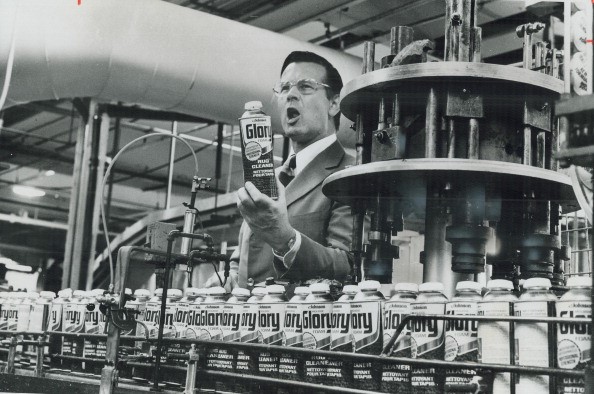Thomas Midgley Jr., the developer of leaded gasoline and CFCs, saw initial acclaim for his inventions’ functions; however, broader environmental consequences became known and the criticism began.

CANADA – AUGUST 28: A Halt in use of Freon as a propellant in aerosol cans was announced by F. F. Wiley; president of S. C. Johnson & Son Ltd. Wiley is shown looking over production line of spray rug cleaner at the firm’s Brantford plant. A ban on Freon was urged at inquest into death of a youth who sniffed a cooking spray. Environmentalists say it is one of chemicals destroying the earth’s protective ozone layer. (Photo by Doug Griffin/Toronto Star via Getty Images)
Maliyah Simone, CRDN
August 25, 2025
The history of science often highlights great thinkers and clever ideas. But few people show the complicated, often unexpected, results of inventions as clearly as Thomas Midgley Jr. During his time, he was praised as a brilliant mind who solved big industrial problems. Yet, his most famous creations—leaded gasoline and chlorofluorocarbons (CFCs)—are now strongly criticized. They are seen as major causes of serious environmental and public health issues, making his otherwise celebrated career seemingly contradictory.
Born into a family of inventors, Midgley’s work in the early 1900s was first praised for how well it worked right away. His first big achievement was finding a solution to the common problem of “engine knock” in car engines. In 1921, after many tests, Midgley found that adding tetraethyl lead (TEL) to gasoline made engines run much better and more efficiently. This invention, sold as “Ethyl” gasoline, was quickly adopted around the world, changing the growing car and airplane industries.
The promise of smoother, more powerful engines hid the early, but serious, warnings from health experts about the natural harmfulness of lead. In fact, Midgley himself got lead poisoning during his research. This was a bad sign of the widespread lead pollution that would fill the air and affect people’s bodies for decades. What was once a celebrated fix for engine performance became, by the late 20th century, a clear example of industry’s carelessness. The utilization of leaded gasoline slowly tapered off worldwide due to its proven links to brain damage, especially in children; as well as widespread environmental contamination.
Another “Miracle” That Caused Harm
Midgley’s next invention was his creation of chlorofluorocarbons (CFCs) in 1928, most notably Freon. He was asked to find a safer, non-flammable, and non-toxic alternative to existing refrigerants, which had caused deadly accidents in the past. Midgley’s CFCs were praised as a “miracle compound.” They didn’t react with other chemicals and seemed safe and were quickly used in refrigerators, air conditioning systems, and later, aerosol sprays.
For decades, CFCs were essential, representing modern convenience and safety in everyday products. However, the very stability that made them seem harmless on the ground turned out to be their environmental downfall in the upper atmosphere. After years of widespread use, scientific research conducted in the 1970s showed that CFCs were moving up to the stratosphere where the sunlight then broke them down, releasing chlorine atoms which quickly destroyed Earth’s protective ozone layer. This discovery led to global concern and, eventually, the Montreal Protocol; an international agreement that required the gradual stopping of CFC production. What was once a celebrated example of clever chemical work became a strong sign of a worldwide environmental danger.
The Lasting Lesson of Innovation
The story of Thomas Midgley Jr. is a perfect example of the complicated connection between new ideas and unexpected results. Midgley’s inventions, created to solve problems and improve safety, eventually caused huge environmental damage on a global scale. This contradiction makes us look closely at the responsibility of science. It highlights that the immediate usefulness of a discovery can be very different from its long-term effects on society and the environment. This challenge pushes future generations to consider not just what is possible, but what is truly good for our planet.
